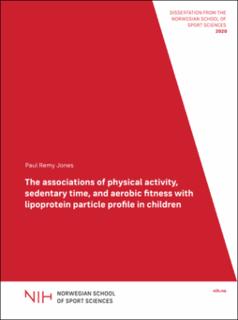| dc.contributor.author | Jones, Paul Remy | |
| dc.date.accessioned | 2020-12-17T08:40:43Z | |
| dc.date.available | 2020-12-17T08:40:43Z | |
| dc.date.issued | 2020 | |
| dc.identifier.isbn | 978-82-502-0586-4 | |
| dc.identifier.uri | https://hdl.handle.net/11250/2719957 | |
| dc.description | Avhandling (doktorgrad) - Norges idrettshøgskole, 2020 | en_US |
| dc.description.abstract | Introduction: Metabolomics can elucidate the metabolites and pathways of human metabolism. Its application in epidemiological studies promises to improve our understanding of health and its connection to lifestyle behaviours, such as physical activity.
Purpose: I. To examine the cross-sectional and prospective associations of physical activity, sedentary time, and aerobic fitness with a detailed lipoprotein profile. II. To consider the theoretical effect on the lipoprotein profile of replacing time spent sedentary with an equal amount of time in moderate- to vigorous-intensity physical activity (MVPA). III. To determine whether daily time spent participating in MVPA moderates the prospective associations between aerobic fitness and lipoprotein subclass particle numbers. IV. To investigate the extent to which the associations of physical activity, sedentary time, and aerobic fitness with the lipoprotein profile are attenuated or confounded by adiposity.
Participants and methods: The information is taken from the Active Smarter Kids (ASK) study, which was a cluster randomised controlled trial of a school-based physical activity intervention conducted over one academic year in 2014–15. The participants were children in the fifth grade whom attended school in Sogn and Fjordane county, Norway. Of those children invited and eligible to participate, 1129 underwent baseline testing. The children were retested towards the end of the intervention period. Physical activity and sedentary time were measured using accelerometers, and aerobic fitness assessed as the distance run in the Andersen intermittent running test. The circulating lipoprotein profile was quantified using proton nuclear magnetic resonance spectroscopy. Waist circumference was used as a proxy for adiposity.
Main results: I. Higher levels of moderate-intensity physical activity (MPA) and vigorousintensity physical activity (VPA) were associated with an apparently favourable lipoprotein II profile in both cross-sectional and prospective analyses. The most marked associations were with measures of very low-density lipoproteins (VLDLs). In the light-intensity physical activity (LPA) analyses, the associations were generally more modest. More time spent sedentary was associated with an apparently unfavourable profile. The associations were typically the inverse of those in the VPA analyses. The pattern of associations between aerobic fitness and the lipoprotein profile was very similar to that with VPA. II. Substituting 30 minutes of MVPA for an equal amount of sedentary time resulted in a lipoprotein profile comparable to that of the single activity MVPA analysis. III. MVPA appears to moderate the beneficial associations between aerobic fitness and the circulating numbers of larger VLDL particles in those children with lower aerobic fitness levels. IV. Adiposity attenuated many of the individual associations in most analyses. This effect was more pronounced in the aerobic fitness analyses.
Conclusions: Physical activity of at least moderate intensity appears beneficial for lipoprotein metabolism as a result of reductions in the number of circulating VLDL particles, possibly due to an acute exercise-induced energy deficit. Light-intensity physical activity seems of limited influence. The unfavourable associations of sedentary time are potentially attributable, at least in part, to less time spent physically active as opposed to a direct consequence of more time spent sedentary. Replacing sedentary time with MVPA theoretically ameliorates these detrimental associations. Though aerobic fitness appears of benefit, the associations are heavily influenced, possibly confounded, by adiposity levels. The associations of physical activity and sedentary time appear partly independent of adiposity. These results suggest that increasing PA levels in children could benefit lipoprotein metabolism, especially in less fit children. A concomitant reduction in sedentary time and adiposity would likely be synergistic. | en_US |
| dc.language.iso | eng | en_US |
| dc.relation.haspart | Paper I: Jones PR, Rajalahti T, Resaland GK, Aadland E, Steene-Johannessen J, Anderssen SA, Bathen TF, Andreassen T, Kvalheim OM, Ekelund U. Associations of physical activity and sedentary time with lipoprotein subclasses in Norwegian schoolchildren: The Active Smarter Kids (ASK) study. Atherosclerosis 2019; 288: 186–93. | |
| dc.relation.haspart | Paper II: Jones PR, Rajalahti T, Resaland GK, Aadland E, Steene-Johannessen J, Anderssen SA, Bathen TF, Andreassen T, Kvalheim OM, Ekelund U. Prospective associations between aerobic fitness and lipoprotein subclasses in a cohort of Norwegian schoolchildren. | |
| dc.relation.haspart | Paper III: Jones PR, Rajalahti T, Resaland GK, Aadland E, Steene-Johannessen J, Anderssen SA, Bathen TF, Andreassen T, Kvalheim OM, Ekelund U. Associations of lipoprotein profile and objectively measured physical activity and sedentary time in schoolchildren: a prospective
cohort study. | |
| dc.relation.haspart | Paper IV: Jones PR, Rajalahti T, Resaland GK, Aadland E, Steene-Johannessen J, Anderssen SA, Bathen TF, Andreassen T, Kvalheim OM, Ekelund U. Moderation of the association between aerobic fitness and lipoprotein subclass particle numbers by moderate- to vigorous-intensity physical activity: a prospective cohort study. | |
| dc.subject | nih | en_US |
| dc.subject | doktoravhandlinger | en_US |
| dc.title | The associations of physical activity, sedentary time, and aerobic fitness with lipoprotein particle profile in children | en_US |
| dc.type | Doctoral thesis | en_US |
| dc.description.localcode | Institutt for idrettsmedisinske fag / Department of Sports Medicine | en_US |
